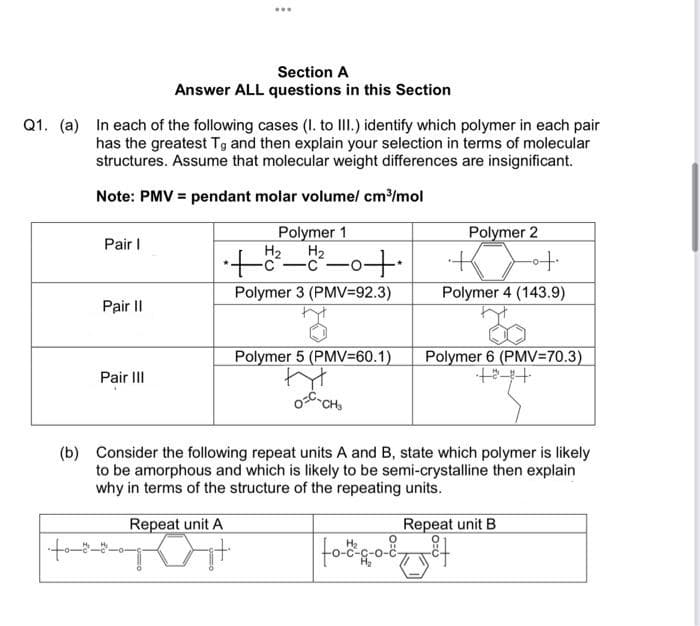Q1. (a) In each of the following cases (I. to III.) identify which polymer in each pair has the greatest Tg and then explain your selection in terms of molecular structures. Assume that molecular weight differences are insignificant. Note: PMV = pendant molar volume/ cm³/mol Polymer 1 H₂ ・++・ 2²-²-0+. Polymer 3 (PMV=92.3) Pair I Pair II Pair III Polymer 5 (PMV-60.1) OC-CH₂ Polymer 2 -ot. Polymer 4 (143.9) Polymer 6 (PMV=70.3) +++ (b) Consider the following repeat units A and B, state which polymer is likely to be amorphous and which is likely to be semi-crystalline then explain why in terms of the structure of the repeating units.
Q1. (a) In each of the following cases (I. to III.) identify which polymer in each pair has the greatest Tg and then explain your selection in terms of molecular structures. Assume that molecular weight differences are insignificant. Note: PMV = pendant molar volume/ cm³/mol Polymer 1 H₂ ・++・ 2²-²-0+. Polymer 3 (PMV=92.3) Pair I Pair II Pair III Polymer 5 (PMV-60.1) OC-CH₂ Polymer 2 -ot. Polymer 4 (143.9) Polymer 6 (PMV=70.3) +++ (b) Consider the following repeat units A and B, state which polymer is likely to be amorphous and which is likely to be semi-crystalline then explain why in terms of the structure of the repeating units.
Chemistry
10th Edition
ISBN:9781305957404
Author:Steven S. Zumdahl, Susan A. Zumdahl, Donald J. DeCoste
Publisher:Steven S. Zumdahl, Susan A. Zumdahl, Donald J. DeCoste
Chapter1: Chemical Foundations
Section: Chapter Questions
Problem 1RQ: Define and explain the differences between the following terms. a. law and theory b. theory and...
Related questions
Question

Transcribed Image Text:Q1. (a) In each of the following cases (I. to III.) identify which polymer in each pair
has the greatest Tg and then explain your selection in terms of molecular
structures. Assume that molecular weight differences are insignificant.
Note: PMV = pendant molar volume/ cm³/mol
Pair I
Section A
Answer ALL questions in this Section
Pair II
Pair III
Polymer 1
H₂
+²2² 0+.
Repeat unit A
ht
Polymer 3 (PMV=92.3)
3
Polymer 5 (PMV-60.1)
tyt
OC-CH₂
Polymer 2
| to-0²-0-0
H₂
+
-ot
Polymer 4 (143.9)
(b) Consider the following repeat units A and B, state which polymer is likely
to be amorphous and which is likely to be semi-crystalline then explain
why in terms of the structure of the repeating units.
to ***
Polymer 6 (PMV=70.3)
Repeat unit B
t
Expert Solution
This question has been solved!
Explore an expertly crafted, step-by-step solution for a thorough understanding of key concepts.
Step by step
Solved in 2 steps

Knowledge Booster
Learn more about
Need a deep-dive on the concept behind this application? Look no further. Learn more about this topic, chemistry and related others by exploring similar questions and additional content below.Recommended textbooks for you

Chemistry
Chemistry
ISBN:
9781305957404
Author:
Steven S. Zumdahl, Susan A. Zumdahl, Donald J. DeCoste
Publisher:
Cengage Learning

Chemistry
Chemistry
ISBN:
9781259911156
Author:
Raymond Chang Dr., Jason Overby Professor
Publisher:
McGraw-Hill Education

Principles of Instrumental Analysis
Chemistry
ISBN:
9781305577213
Author:
Douglas A. Skoog, F. James Holler, Stanley R. Crouch
Publisher:
Cengage Learning

Chemistry
Chemistry
ISBN:
9781305957404
Author:
Steven S. Zumdahl, Susan A. Zumdahl, Donald J. DeCoste
Publisher:
Cengage Learning

Chemistry
Chemistry
ISBN:
9781259911156
Author:
Raymond Chang Dr., Jason Overby Professor
Publisher:
McGraw-Hill Education

Principles of Instrumental Analysis
Chemistry
ISBN:
9781305577213
Author:
Douglas A. Skoog, F. James Holler, Stanley R. Crouch
Publisher:
Cengage Learning

Organic Chemistry
Chemistry
ISBN:
9780078021558
Author:
Janice Gorzynski Smith Dr.
Publisher:
McGraw-Hill Education

Chemistry: Principles and Reactions
Chemistry
ISBN:
9781305079373
Author:
William L. Masterton, Cecile N. Hurley
Publisher:
Cengage Learning

Elementary Principles of Chemical Processes, Bind…
Chemistry
ISBN:
9781118431221
Author:
Richard M. Felder, Ronald W. Rousseau, Lisa G. Bullard
Publisher:
WILEY